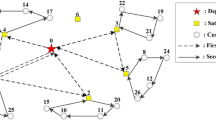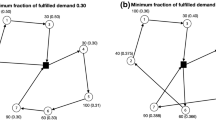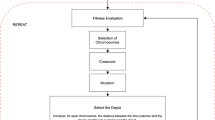Abstract
With the gradual increase of commercial banks and the expansion of their branches, the demand for cash transportation inflates sharply, bringing opportunities to the business development of Cash-In-Transit (CIT) sectors. However, the branches are often distributed in densely populated areas where traffic jams occur from time to time, which poses a severe challenge to the route planning of CIT vehicles. In addition, risk factors need to be considered during the optimization process because the goods transported belong to valuables. In order to effectively deal with the routing problem of CIT sectors, this paper established a bi-objective model and a goal programming model of Risk-Constrained Multi Depot Vehicle Routing Problems (RCMDVRPs) using real-time traffic data. Based on the traditional genetic algorithm, a Hybrid Genetic Algorithm with Intensification procedures (HGAI) is proposed to solve the goal programming model by using a three-level linked list structure to express chromosomes visually. Then, a new Self-constrained Hybrid Genetic Algorithm (SHGA) is designed for the bi-objective model. Besides, an online path updating strategy is developed to guide remote vehicles against time-dependent traffic flows. Finally, the HGAI is performed on benchmark instances to verify its accuracy. Experimental results of performance test show that the algorithm can achieve a gap of about 3% compared with the Best Known Result (BKR). The results of a case study also show that the two models and the corresponding algorithms are feasible and can be used to solve large-scale problems according to the special preferences and goals of decision-makers.










Similar content being viewed by others
Abbreviations
- CIT:
-
Cash-in-transit
- RCMDVRP:
-
Risk-constrained multi depot vehicle routing problem
- HGAI:
-
Hybrid genetic algorithm with intensification procedures
- SHGA:
-
Self-constrained hybrid genetic algorithm
- BKR:
-
Best known result
- VRP:
-
Vehicle routing problem
- MDVRP:
-
Multi depot vehicle routing problem
- CTVRP:
-
Cash-in-transit vehicle routing problem
- GA:
-
Genetic algorithm
- ACO:
-
Ant colony optimization
- NP:
-
Nondeterministic polynomial-time
- RCTVRP:
-
Risk-constrained cash-in-transit vehicle routing problem
- NSGA:
-
Nondominated sorting genetic algorithm
- ALNS:
-
Adaptive large neighborhood search
- CO2 :
-
Carbon dioxide
- FGVRP:
-
Fuel-efficient green vehicle routing problem
- GCVRP:
-
Green capacitated vehicle routing problem
- GP:
-
Goal programming
- VRPTW:
-
Vehicle routing problem with time windows
- CVRP:
-
Capacitated vehicle routing problem
- EC:
-
Energy consumption
- CO:
-
Carbon monoxide
- NOx :
-
Nitrogen oxide
- VOC:
-
Volatile organic compounds
- PM:
-
Particulate matter
- COPERT:
-
Computer program to calculate emissions from road transport
- LDV:
-
Light-duty diesel vehicle
- FC:
-
Fuel consumption
- EF:
-
Emission factor
- MCDM:
-
Multi-criteria decision making
- MOP:
-
Multi-objective optimization problem
- PFIH:
-
Push-forward insertion heuristic
- BCRC:
-
Best cost route crossover
- IM:
-
Intensification method
- DC:
-
Distribution center
- ETA:
-
Estimated time of arrival
- TSP:
-
Traveling salesman problem
- i :
-
Customers, nodes, depots, goals
- j :
-
Customers, nodes, depots
- k:
-
Vehicles
- \(N = \left\{ {1, \ldots ,n} \right\}\) :
-
The set of customers
- \(S = \left\{ {{\text{DC}}1,{\text{DC}}2,...} \right\}\) :
-
The set of depots
- \(V = S \cup N\) :
-
The set of nodes
- \(A = {\text{arc}}(i,j),i,j \in V,i \ne j\) :
-
The set of arcs
- \(K = \left\{ {1, \ldots ,m} \right\}\) :
-
The set of vehicles
- \(q_{i}\) :
-
The demand of customer i
- \({\text{st}}_{i}\) :
-
The service time of customer i
- \(d_{ij}\) :
-
The travel distance on arc(i, j)
- \(t_{ij}\) :
-
The travel time on arc(i, j)
- \(T\) :
-
The efficient working time (the length of time windows)
- \(Q\) :
-
The capacity of vehicles
- \(D_{ik}\) :
-
The onboard cash when the vehicle k departs from customer i
- \(R_{i}^{k}\) :
-
The risk index when the vehicle k departs from customer i
- \(\theta\) :
-
The threshold for global risk index
- \(M,M^{{\prime }}\) :
-
Two big enough numbers
- \(b = [b_{1} ,b_{2} , \ldots ]\) :
-
Goal vector
- \(w = \left[ {\left( {w_{{b_{1} }}^{ - } ,w_{{b_{1} }}^{ + } } \right),\left( {w_{{b_{2} }}^{ - } ,w_{{b_{2} }}^{ + } } \right), \ldots } \right]\) :
-
Weight vector
- \(\overline{n}_{i} ,\overline{p}_{i}\) :
-
Unwanted deviational variables of the i-th goal
- \(x_{ijk}\) :
-
Equals 1 if the arc (i, j) is traversed by vehicle k; 0 otherwise
- \(y_{ik}\) :
-
Equals 1 if node i,\(i \in V\) is served by vehicle k; 0 otherwise
- \(u_{ik}\) :
-
Auxiliary variable for sub-tour elimination constraints in route k
References
Aksoy, D. (2020). Operational management challenges for cash-in-transit services during an outbreak of a global disease. 5. International EMI Entrepreneurship and Social Sciences Congress PROCEEDINGS E-BOOK.
Androutsopoulos, K. N., & Zografos, K. G. (2012). A bi-objective time-dependent vehicle routing and scheduling problem for hazardous materials distribution. EURO Journal on Transportation and Logistics, 1(1), 157–183.
Arostegui, M. A., Kadipasaoglu, S. N., & Khumawala, B. M. (2006). An empirical comparison of Tabu Search, Simulated Annealing, and Genetic Algorithms for facilities location problems. International Journal of Production Economics, 103(2), 742–754.
Azadeh, A., & Farrokhi-Asl, H. (2019). The close–open mixed multi depot vehicle routing problem considering internal and external fleet of vehicles. Transportation Letters, 11(2), 78–92.
Bae, H., & Moon, I. (2016). Multi-depot vehicle routing problem with time windows considering delivery and installation vehicles. Applied Mathematical Modelling, 40(13), 6536–6549.
Bolanos, R., Escobar, J., & Echeverri, M. (2018). A metaheuristic algorithm for the multi-depot vehicle routing problem with heterogeneous fleet. International Journal of Industrial Engineering Computations, 9(4), 461–478.
Boussaïd, I., Lepagnot, J., & Siarry, P. (2013). A survey on optimization metaheuristics. Information Sciences, 237, 82–117.
Bula, G. A., Murat Afsar, H., González, F. A., Prodhon, C., & Velasco, N. (2019). Bi-objective vehicle routing problem for hazardous materials transportation. Journal of Cleaner Production, 206, 976–986.
Calvete, H. I., Galé, C., Oliveros, M.-J., & Sánchez-Valverde, B. (2007). A goal programming approach to vehicle routing problems with soft time windows. European Journal of Operational Research, 177(3), 1720–1733.
CBA. (2021). 2020 Annual Report on the Development of China's Banking Industry. Retrieved 24, March, 2021, from https://www.china-cba.net/.
Chang, Y. H. (2011). The cash pick-up and delivery vehicle routing/scheduling under stochastic travel times. National Central University.
Charnes, A., & Cooper, W. W. (1977). Goal programming and multiple objective optimizations: Part 1. European Journal of Operational Research, 1(1), 39–54.
Chen, Y., Cowling, P., Polack, F., Remde, S., & Mourdjis, P. (2017). Dynamic optimisation of preventative and corrective maintenance schedules for a large scale urban drainage system. European Journal of Operational Research, 257(2), 494–510.
Crevier, B., Cordeau, J.-F., & Laporte, G. (2007). The multi-depot vehicle routing problem with inter-depot routes. European Journal of Operational Research, 176(2), 756–773.
Demir, E., Bektaş, T., & Laporte, G. (2014). The bi-objective pollution-routing problem. European Journal of Operational Research, 232(3), 464–478.
Dokeroglu, T., Sevinc, E., Kucukyilmaz, T., & Cosar, A. (2019). A survey on new generation metaheuristic algorithms. Computers & Industrial Engineering, 137, 106040.
EMISIA. (2021). The environmental tools of COPERTE V. Retrieved 3, March, 2021, from https://www.emisia.com/.
Ghaderi, A., & Burdett, R. L. (2019). An integrated location and routing approach for transporting hazardous materials in a bi-modal transportation network. Transportation Research Part E: Logistics and Transportation Review, 127, 49–65.
Ghoseiri, K., & Ghannadpour, S. F. (2010). Multi-objective vehicle routing problem with time windows using goal programming and genetic algorithm. Applied Soft Computing, 10(4), 1096–1107.
Google. (2021). Solving a TSP with OR-Tools. Retrieved 7 January, 2021, from https://developers.google.cn/optimization/routing/tsp.
Ho, W., Ho, G. T. S., Ji, P., & Lau, H. C. W. (2008). A hybrid genetic algorithm for the multi-depot vehicle routing problem. Engineering Applications of Artificial Intelligence, 21(4), 548–557.
Hosken, G. (2018). The fightback against cash heists is on—And technology should be the ultimate weapon. Retrieved 25, March, 2021, from https://www.timeslive.co.za/news/south-africa/2018-07-24-the-fightback-against-cash-heists-is-on--and-technology-should-be-the-ultimate-weapon/.
Irawan, W., Manaqib, M., & Fitriyati, N. (2021). Implementation of the model capacited vehicle routing problem with time windows with a goal programming approach in determining the best route for goods distribution. Jurnal Matematika, Statistika Dan Komputasi, 17(2), 231–239.
Ji, Y., Du, J., Wu, X., Wu, Z., Qu, D., & Yang, D. (2021). Robust optimization approach to two-echelon agricultural cold chain logistics considering carbon emission and stochastic demand. Environment, Development and Sustainability.
Karakatič, S., & Podgorelec, V. (2015). A survey of genetic algorithms for solving multi depot vehicle routing problem. Applied Soft Computing, 27, 519–532.
Kazantzi, V., Kazantzis, N., & Gerogiannis, V. C. (2011). Risk informed optimization of a hazardous material multi-periodic transportation model. Journal of Loss Prevention in the Process Industries, 24(6), 767–773.
Khairy, O. M., Shehata, O. M., & Morgan, E. I. (2020). Meta-heuristic algorithms for solving the multi-depot vehicle routing problem. In 2020 2nd Novel intelligent and leading emerging sciences conference (NILES).
Kumar, A., Roy, D., Verter, V., & Sharma, D. (2018). Integrated fleet mix and routing decision for hazmat transportation: A developing country perspective. European Journal of Operational Research, 264(1), 225–238.
Lacomme, P., Prins, C., & Sevaux, M. (2006). A genetic algorithm for a bi-objective capacitated arc routing problem. Computers and Operations Research, 33(12), 3473–3493.
Laporte, G. (1984). Optimal solutions to capacitated multidepot vehicle routing problems. Congressus Nemerantium, 4, 283–292.
Li, G. (2009). Research on open vehicle routing problem with time windows based on improved genetic algorithm. In 2009 International conference on computational intelligence and software engineering.
Liu, F., Fang, K., Tang, J., & Yin, Y. (2021). Solving the rotating seru production problem with dynamic multi-objective evolutionary algorithms. Journal of Management Science and Engineering.
Loomis. (2021). We are the international specialist in cash handling. Retrieved 25, March, 2021, from https://www.loomis.com/en/business-markets.
Martí, R., Luis González Velarde, J., & Duarte, A. (2009). Heuristics for the bi-objective path dissimilarity problem. Computers & Operations Research, 36(11): 2905–2912.
Masri, H., Ben Abdelaziz, F., & Alaya, H. (2016). A recourse stochastic goal programming approach for the multi-objective stochastic vehicle routing problem. Journal of Multi-Criteria Decision Analysis, 23(1–2), 3–14.
Mavrotas, G. (2009). Effective implementation of the ε-constraint method in multi-objective mathematical programming problems. Applied Mathematics and Computation, 213(2), 455–465.
Muazu, A. A., & Nura, A. (2020). Efficient assignment algorithms for multi depot vehicle routing problem using genetic algorithm. Ilorin Journal of Computer Science and Information Technology, 3(1), 1–10.
Musa, A. A. (2021). Goal programming model for optimal water allocation of limited resources under increasing demands. Environment, Development and Sustainability, 23(4), 5956–5984.
Ntziachristos, L., & Samaras, Z. (2000). COPERT III, Computer programme to calculate emissions from road transport. Copenhagen, European Energy Agency (EEA).
Ombuki, B., Ross, B. J., & Hanshar, F. (2006). Multi-objective genetic algorithms for vehicle routing problem with time windows. Applied Intelligence, 24(1), 17–30.
Ombuki-Berman, B., & Hanshar, F. T. (2009). Using genetic algorithms for multi-depot vehicle routing. In F. B. Pereira and J. Tavares (Eds.), Bio-inspired algorithms for the vehicle routing problem, pp. 77–99. Springer.
Parsafard, M., Esmaeel, A., Masoud, K., Mohammadreza, N., & Li, X. (2015). Practical approach for finding optimum routes for fuel delivery trucks in large cities. Transportation Research Record, 2478(1), 66–74.
Pisinger, D., & Ropke, S. (2007). A general heuristic for vehicle routing problems. Computers and Operations Research, 34(8), 2403–2435.
Poonthalir, G., & Nadarajan, R. (2018). A fuel efficient green vehicle routing problem with varying speed constraint (F-GVRP). Expert Systems with Applications, 100, 131–144.
Pradhananga, R., Taniguchi, E., & Yamada, T. (2010). Ant colony system based routing and scheduling for hazardous material transportation. Procedia—Social and Behavioral Sciences, 2(3), 6097–6108.
Pradhananga, R., Taniguchi, E., Yamada, T., & Qureshi, A. G. (2014a). Bi-objective decision support system for routing and scheduling of hazardous materials. Socio-Economic Planning Sciences, 48(2), 135–148.
Pradhananga, R., Taniguchi, E., Yamada, T., & Qureshi, A. G. (2014b). Environmental analysis of pareto optimal routes in hazardous material transportation. Procedia—Social and Behavioral Sciences, 125, 506–517.
Sai, S., Kumar, L. A., & Paneerselvam, S. (2018). Computational intelligence paradigms for optimization problems using MATLAB®/SIMULINK®.
Shuib, A., & Muhamad, N. A. (2018). Mixed integer multi-objective goal programming model for green capacitated vehicle routing problem. Advances in Transportation and Logistics Research, 1, 356–368.
Singh, V., Ganapathy, L., & Pundir, A. K. (2021). An improved genetic algorithm for solving multi depot Vehicle Routing Problems. Research anthology on multi-industry uses of genetic programming and algorithms, IGI Global: 375–402.
Skok, M., Skrlec, D., & Krajcar, S. (2000). The genetic algorithm method for multiple depot capacitated vehicle routing problem solving. In KES'2000. Fourth international conference on knowledge-based intelligent engineering systems and allied technologies. proceedings (Cat. No.00TH8516).
Soriano, A., Vidal, T., Gansterer, M., & Doerner, K. (2020). The vehicle routing problem with arrival time diversification on a multigraph. European Journal of Operational Research, 286(2), 564–575.
Talarico, L., Sörensen, K., & Springael, J. (2015a). The k-dissimilar vehicle routing problem. European Journal of Operational Research, 244(1), 129–140.
Talarico, L., Sörensen, K., & Springael, J. (2015b). Metaheuristics for the risk-constrained cash-in-transit vehicle routing problem. European Journal of Operational Research, 244(2), 457–470.
Talarico, L., Springael, J., Sorensen, K., & Talarico, F. (2017). A large neighbourhood metaheuristic for the risk-constrained cash-in-transit vehicle routing problem. Computers & Operations Research, 78, 547–556.
Tam, V., & Ma, K. (2008). An effective search framework combining meta-heuristics to solve the vehicle routing problems with time windows. Vehicle Routing Problem, 35.
Thobane, M. S. (2019). The South African cash-in-transit heist enterprise: Managing its wellspring and concatenation. International Annals of Criminology, 57(1–2), 198–224.
Wink, S., Bäck, T., & Emmerich, M. (2012). A meta-genetic algorithm for solving the capacitated vehicle routing problem. In 2012 IEEE congress on evolutionary computation.
Xing, L., Rohlfshagen, P., Chen, Y., & Yao, X. (2010). An evolutionary approach to the multidepot capacitated arc routing problem. IEEE Transactions on Evolutionary Computation, 14(3), 356–374.
Yan, S. Y., Wang, S. S., & Wu, M. W. (2012). A model with a solution algorithm for the cash transportation vehicle routing and scheduling problem. Computers and Industrial Engineering, 63(2), 464–473.
Youssef, H., Sait, S. M., & Adiche, H. (2001). Evolutionary algorithms, simulated annealing and tabu search: A comparative study. Engineering Applications of Artificial Intelligence, 14(2), 167–181.
Zajac, S., & Huber, S. (2021). Objectives and methods in multi-objective routing problems: A survey and classification scheme. European Journal of Operational Research, 290(1), 1–25.
Zakariazadeh, A., Jadid, S., & Siano, P. (2014). Multi-objective scheduling of electric vehicles in smart distribution system. Energy Conversion and Management, 79, 43–53.
Zhang, Y., Liu, J., Duan, F., & Ren, J. (2007). Genetic algorithm in vehicle routing problem. In Third international conference on intelligent information hiding and multimedia signal processing (IIH-MSP 2007).
Zhang, Z., Wang, L., Song, X., Huang, H., & Yin, Y. (2021). Improved genetic-simulated annealing algorithm for seru loading problem with downward substitution under stochastic environment. Journal of the Operational Research Society, pp. 1–12.
Acknowledgements
This research was funded by the Chongqing graduate Scientific research innovation Projects [grant numbers CYB20178 and CYB19172]. The authors are grateful to the support of the General Project of Chongqing Natural Science Foundation [grant number cstc2020jcyj-msxmX0108], and the Key scientific and technological innovation project of “Construction of Chengdu-Chongqing Economic Circle” [grant number KJCXZD2020031].
Author information
Authors and Affiliations
Corresponding author
Additional information
Publisher's Note
Springer Nature remains neutral with regard to jurisdictional claims in published maps and institutional affiliations.
Supplementary Information
Below is the link to the electronic supplementary material.
Rights and permissions
About this article
Cite this article
Ge, X., Jin, Y. & Zhang, L. Genetic-based algorithms for cash-in-transit multi depot vehicle routing problems: economic and environmental optimization. Environ Dev Sustain 25, 557–586 (2023). https://doi.org/10.1007/s10668-021-02066-9
Received:
Accepted:
Published:
Issue Date:
DOI: https://doi.org/10.1007/s10668-021-02066-9




